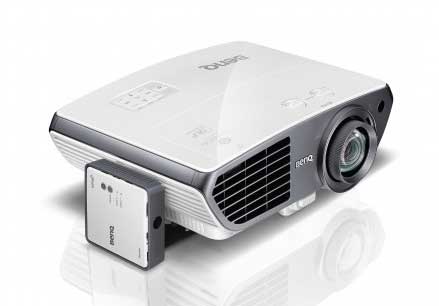BenQ HT4050 Placement Flexibility
Generally I don't consider placement flexibility to be a special feature, but the HT4050 makes a good argument for it to be considered here. Most low cost DLP projectors have no, or little lens shift, and most have zoom lenses with very limited zoom range. Not so the HT4050.
First, the zoom lens is a very healthy 1.6:1 which provides a whole lot of front to back placement. Also interesting is that the zoom lens itself is a little shorter throw than most, allowing the projector to be placable about 8.6 feet from a 100" diagonal 16:9 screen. Few normal projectors let you place closer than about 10 feet. That could be a plus, depending on your setup. (It's still not a true very short throw projector, where the projector would normally be much closer to the screen than the viewers).
The other half of the placement flexibility equation is that the HT4050 has both vertical and horizontal lens shift, something rare in under $2000 DLP projectors. The amount of lens shift is modest compared to 3LCD and LCoS projectors, but is still better than the minimal or none sported by most BenQ, Optoma, and other single chip DLP projectors anywhere near the price. This will help out especially if you are ceiling mounting. We do publish the placement specs (for a 100" screen) in Hardware Tour pages that follow. From those numbers you can easily figure out where you can place the HT4050 relative to whatever size screen you are using.
ISF Certification
The ISF - Imaging Science Foundation, is an organization that among other things certifies professional calibrators. I would say that most of the calibrators out there who can calibrate this, or other projectors for you have ISF certifications. (Some others, like Mike who calibrates the projectors I review, is THX certified, rather than ISF. Ron, who also reviews for us, doesn't hold any calibration certifications, but has the gear and is fully competent as well.

The logo of the Imaging Science Foundation - ISF
When it comes to an ISF certification of a projector, that means several things: First, the projector must have the controls to allow for a proper, accurate calibration to today's standards. Second, the projector must have at least two modes - generally called ISF Day and ISF Night, that the calibrator can access and save their calibration settings in. Those two modes must have password protection so that end users can't get in there and screw things up. A projector may have way more than two savable modes, but those are the requirements for ISF.
Being ISF certified doesn't guarantee great color or other aspects of the picture being in proper balance, right out of the box. Still, it should translate into great color, etc., once a professional calibrator gets their hands on the HT4050.
REC 709
REC 709 is a color standard that has been around since the early 1990s. It's best known as being the color standard for HDTV. For those of you familiar, it is essentially identical to the sRGB color space (which BenQ touts in their Colorific series of business projectors).
The HT4050 (and HT3050) have a color preset mode called REC 709, which of course means they have a mode optimized to deliver the correct color balance when watching.
In other words, if the projector delivers dead on the money REC 709 color, you have a perfectly calibrated (color wise) projector. Don't expect perfect from the HT4050, however, in fact don't expect perfect REC 709 from any projector, right out of the box. Even if a manufacturer has done a particularly good job of pre-calibrating the projector (iffy at best, is our experience, whether REC 709, "THX" or sRGB modes), there's enough variation in lamp output so that no two "out of the box" projectors would sport exactly the same color balance. Remember also, that the color balance of a lamp also shifts over time, and by whether you run it at full power or eco mode.
Despite all of that, the point of having a REC 709 mode is to point out that there's a definable goal, that the mode is trying to achieve. Some other company's Cinema, or Theater, or Movie, or HDTV mode may be similar, and have exactly the same goals, but by calling it a REC 709 mode we can judge just how well it delivers on the promise, by seeing how close it really comes.
HT4050 Projector - CFI - smooth motion aka
CFI - Creative Frame Interpolation - often generically referred to as smooth motion, is called Motion Enhancer by BenQ. BenQ's setup allows three settings: Low, Middle, and High, plus Off. The idea behind CFI is for the device to look ahead at least one frame, see how objects have moved from one frame to the next, and then create a new frame to go in between the two existing frames. Picture a car driving from left to right on your screen. At 30 frames per second, that car might cross the screen in 8 frames - that's 8 steps. With CFI, the frame rate would get doubled to 60 fps, and 30 new frames are created each with the car half way between the frame before and after. The bottom line, with the car moving in more steps you have a smoother motion.
It works. But, there are always trade-offs, so there are typically some motion artifacts around the fast moving part of the image. The better the implementation, the less you notice the artifacts, the more you appreciate the smoothing affect. I prefer CFI only for sports viewing. When viewing sports on the HT4050, I found the Middle setting to be the best, overall (it will vary depending on what's changing on the screen, and how fast, etc). I could see more motion artifacts when looking for them, but not bad. the low settings was a bit weak on its job of smoothing things out. Typically I tend to recommend the low setting in a projector with three choices, but not this time. Hey, try it out, whatever you like. Some of you will use CFI for everything (I hope not movies, at least), others, just sports and general HDTV.
One could argue the right and wrong of using CFI, but I'm a believer in live and let live. If you prefer it on, enjoy. Just remember that it can change the feel of a scene significantly, which is something I find undesirable in most movies. Film based movies no longer look film like.
At least the HT4050 offers you the choice. Many $1000 - $2000 projectors lack any CFI, although more and more are sporting it these days. The HT3050 lacks this feature, so it's one of the extras you are paying for with the HT4050. Use wisely.
HT4050 3D
The HT4050 supports the usual 3D formats. Natively it uses DLP-Link to work with DLP-Link compatible glasses. With DLP-Link, the two eye's separate frame info is embedded in the image. You can notice that by the reddish shift to the black background. The 3D glasses remove that red shift. I instead, however, recommend going for the optional RF emitter, and RF glasses. They have better range, and other picture oriented benefits.
3D viewing was overall, an excellent experience. I had to use DLP-Link glasses as BenQ did not ship me the RF emitter (I have plenty of compatible glasses for all types). The dark red background was just occasionally noticeable, something that would not happen with the RF setup, but "oh well." On the plus side, there is no crosstalk, as DLP projectors are faster than other technologies. While that's never a deal breaker, inherently DLP projectors can produce a cleaner 3D image (if well implemented).
3D brightness was a different story. With 3D eating up typically 2/3 or more of total brightness, the HT4050 managed a reasonably bright image at 100" diagonal. Not really bright enough, but not dim either. Trying to fill my full 124" diagonal was just too much, I couldn't make it through a whole movie without getting up and adjusting the zoom lens to a smaller overall image (close to 100" diagonal) to recover some extra brightness. Bottom line: Very good 3D if limited in brightness.
As the BenQ product manager pointed out to me, the HT4050 also has 2D to 3D conversion. OK, that's hardly unusual, but not high on my list of things, perhaps fun for the kids, especially on those video clips you shoot with your phone.
BenQ HT4050 - Optional Wireless HDMI, Streaming Stick
BenQ offers an optional wireless HDMI solution. That's nice, but it's not built in. So, ultimately, what it comes down to for any projector with standard HDMI, there are plenty of 3rd party wireless solutions. As a result, the bottom line is that it's nice that BenQ offers their own packaged wireless HDMI, but if they didn't there would be plenty of other brands' wireless HDMI to choose from.
BenQ also offers a wireless streaming stick to work with your smart devices, making use of MHL (so it plugs into the MHL enabled HDMI).
That too is a nice option, but remember, there are tons of sticks to choose from, and most offer more available channels. Can't say I would recommend BenQ's stick when you could go with a Roku, or Amazon, or Google, or even Apple TV (Apple TV does need AC power and is physically larger).
 Click Image to Enlarge
Click Image to EnlargeHT4050 Speaker
It's a single 10 watt system. It has a reasonably beefy sound suitable for movie viewing, and you've got some basic equalizer choices in the menus. Still, no internal speaker is remotely a match for even a $199 HTIB - home theater in a box. The speaker though will do just fine for gaming, or that outdoor movie night, and will be just fine for those who just don't care about having great, no - make that serious - sound quality.



